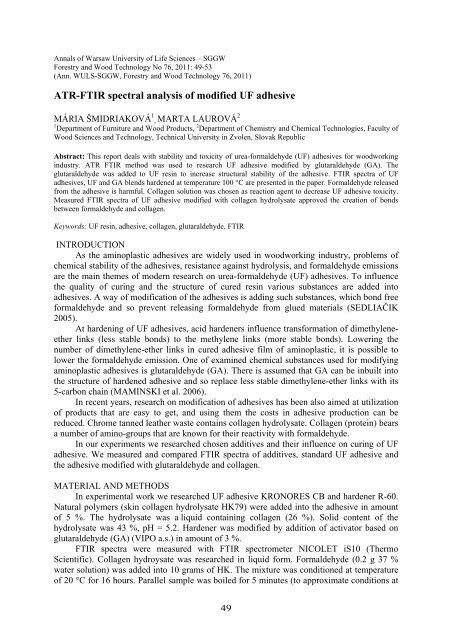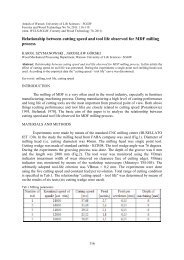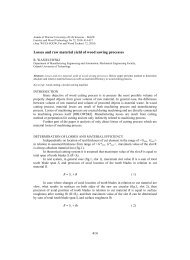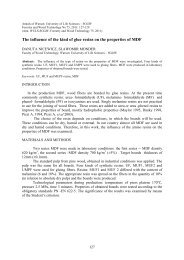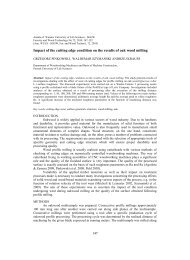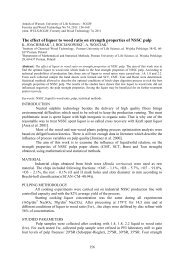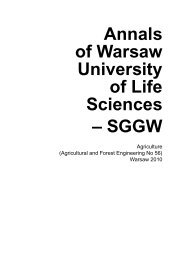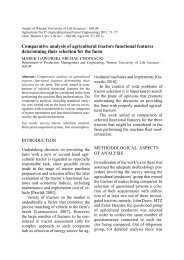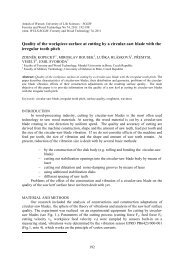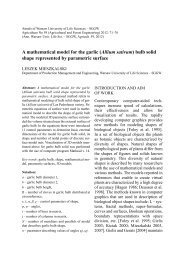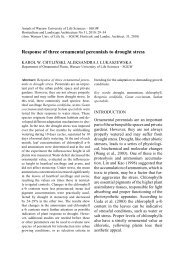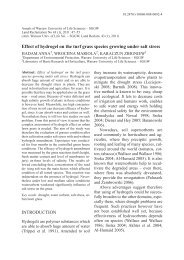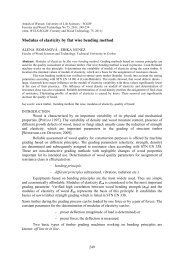Annals of Warsaw University of Life Sciences - SGGW
Annals of Warsaw University of Life Sciences - SGGW
Annals of Warsaw University of Life Sciences - SGGW
Create successful ePaper yourself
Turn your PDF publications into a flip-book with our unique Google optimized e-Paper software.
<strong>Annals</strong> <strong>of</strong> <strong>Warsaw</strong> <strong>University</strong> <strong>of</strong> <strong>Life</strong> <strong>Sciences</strong> – <strong>SGGW</strong><br />
Forestry and Wood Technology No 76, 2011: 49-53<br />
(Ann. WULS-<strong>SGGW</strong>, Forestry and Wood Technology 76, 2011)<br />
ATR-FTIR spectral analysis <strong>of</strong> modified UF adhesive<br />
MÁRIA ŠMIDRIAKOVÁ 1 , MARTA LAUROVÁ 2<br />
1 Department <strong>of</strong> Furniture and Wood Products, 2 Department <strong>of</strong> Chemistry and Chemical Technologies, Faculty <strong>of</strong><br />
Wood <strong>Sciences</strong> and Technology, Technical <strong>University</strong> in Zvolen, Slovak Republic<br />
Abstract: This report deals with stability and toxicity <strong>of</strong> urea-formaldehyde (UF) adhesives for woodworking<br />
industry. ATR FTIR method was used to research UF adhesive modified by glutaraldehyde (GA). The<br />
glutaraldehyde was added to UF resin to increase structural stability <strong>of</strong> the adhesive. FTIR spectra <strong>of</strong> UF<br />
adhesives, UF and GA blends hardened at temperature 100 °C are presented in the paper. Formaldehyde released<br />
from the adhesive is harmful. Collagen solution was chosen as reaction agent to decrease UF adhesive toxicity.<br />
Measured FTIR spectra <strong>of</strong> UF adhesive modified with collagen hydrolysate approved the creation <strong>of</strong> bonds<br />
between formaldehyde and collagen.<br />
Keywords: UF resin, adhesive, collagen, glutaraldehyde, FTIR<br />
INTRODUCTION<br />
As the aminoplastic adhesives are widely used in woodworking industry, problems <strong>of</strong><br />
chemical stability <strong>of</strong> the adhesives, resistance against hydrolysis, and formaldehyde emissions<br />
are the main themes <strong>of</strong> modern research on urea-formaldehyde (UF) adhesives. To influence<br />
the quality <strong>of</strong> curing and the structure <strong>of</strong> cured resin various substances are added into<br />
adhesives. A way <strong>of</strong> modification <strong>of</strong> the adhesives is adding such substances, which bond free<br />
formaldehyde and so prevent releasing formaldehyde from glued materials (SEDLIAČIK<br />
2005).<br />
At hardening <strong>of</strong> UF adhesives, acid hardeners influence transformation <strong>of</strong> dimethyleneether<br />
links (less stable bonds) to the methylene links (more stable bonds). Lowering the<br />
number <strong>of</strong> dimethylene-ether links in cured adhesive film <strong>of</strong> aminoplastic, it is possible to<br />
lower the formaldehyde emission. One <strong>of</strong> examined chemical substances used for modifying<br />
aminoplastic adhesives is glutaraldehyde (GA). There is assumed that GA can be inbuilt into<br />
the structure <strong>of</strong> hardened adhesive and so replace less stable dimethylene-ether links with its<br />
5-carbon chain (MAMINSKI et al. 2006).<br />
In recent years, research on modification <strong>of</strong> adhesives has been also aimed at utilization<br />
<strong>of</strong> products that are easy to get, and using them the costs in adhesive production can be<br />
reduced. Chrome tanned leather waste contains collagen hydrolysate. Collagen (protein) bears<br />
a number <strong>of</strong> amino-groups that are known for their reactivity with formaldehyde.<br />
In our experiments we researched chosen additives and their influence on curing <strong>of</strong> UF<br />
adhesive. We measured and compared FTIR spectra <strong>of</strong> additives, standard UF adhesive and<br />
the adhesive modified with glutaraldehyde and collagen.<br />
MATERIAL AND METHODS<br />
In experimental work we researched UF adhesive KRONORES CB and hardener R-60.<br />
Natural polymers (skin collagen hydrolysate HK79) were added into the adhesive in amount<br />
<strong>of</strong> 5 %. The hydrolysate was a liquid containing collagen (26 %). Solid content <strong>of</strong> the<br />
hydrolysate was 43 %, pH = 5.2. Hardener was modified by addition <strong>of</strong> activator based on<br />
glutaraldehyde (GA) (VIPO a.s.) in amount <strong>of</strong> 3 %.<br />
FTIR spectra were measured with FTIR spectrometer NICOLET iS10 (Thermo<br />
Scientific). Collagen hydroysate was researched in liquid form. Formaldehyde (0.2 g 37 %<br />
water solution) was added into 10 grams <strong>of</strong> HK. The mixture was conditioned at temperature<br />
<strong>of</strong> 20 °C for 16 hours. Parallel sample was boiled for 5 minutes (to approximate conditions at<br />
49


